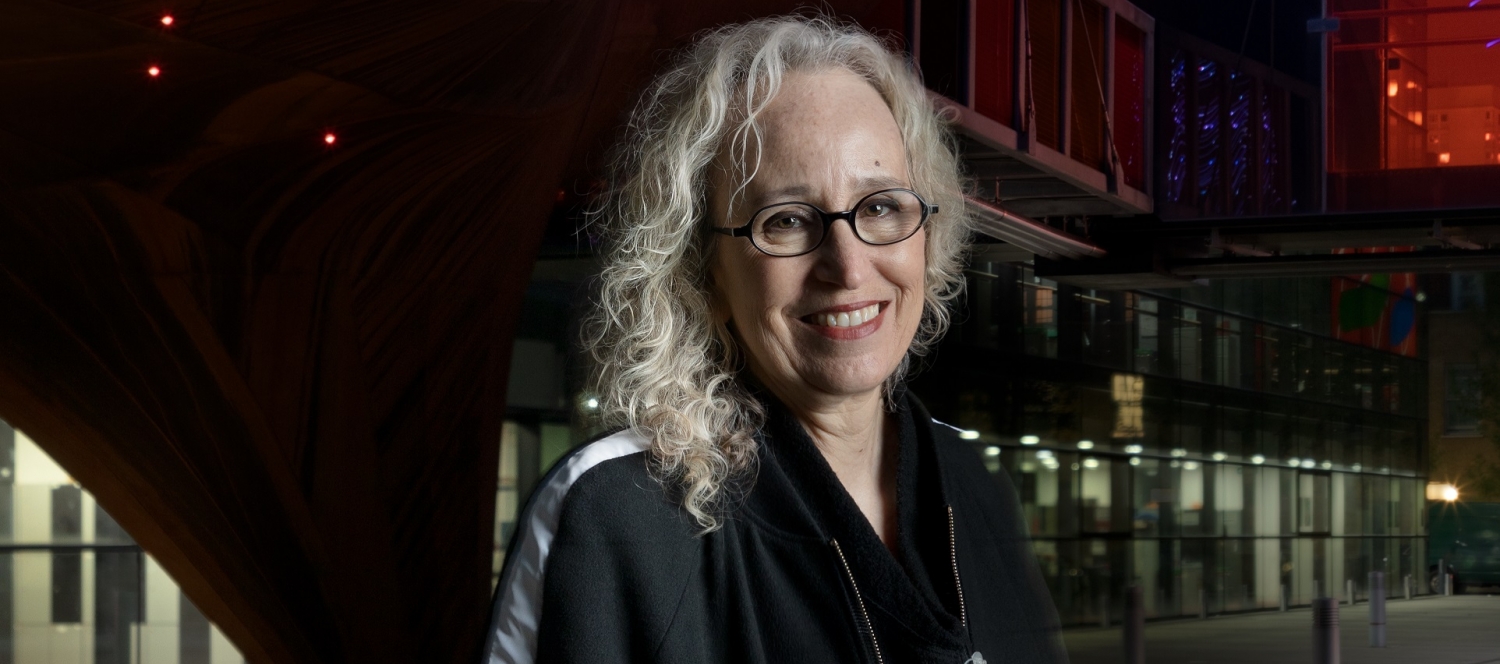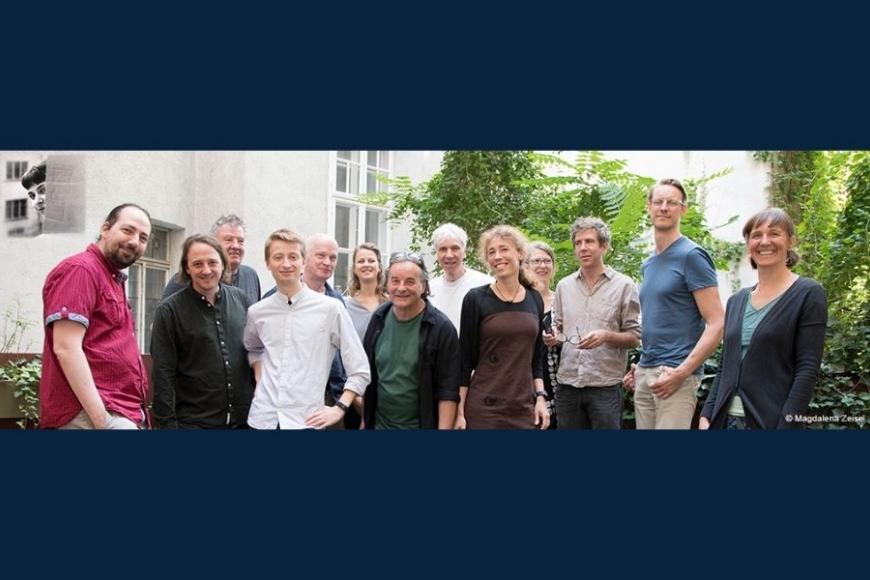Interview: Yael Reisner

Journal Preview Die Forscherin und Architektin Yael Reisner scheut sich nicht davor, das „S-Wort“ in den architektonischen Diskurs einzubringen. Sie kuratierte die Tallinn Biennale 2019, bei der sie den Fokus auf den Begriff und die Bedeutung von Schönheit in der Architektur richtete. In unserem Gespräch erzählt sie, weshalb Ästhetik mehr als nur Ansichtssache ist.
Seit wann und warum begannen Sie sich für die Schönheit in der Architektur zu interessieren?
Mein Feldzug in der Sache als Architektin und engagierte Beobachterin des zeitgenössischen architektonischen Diskurses begann etwa 1996 während meiner Lehrtätigkeit an der UCL Bartlett School of Architecture, wo ich – zu der Zeit noch als Einzelkämpferin in der KollegInnenschaft – dafür plädierte, durch architektonische Gestaltung ein breiteres Spektrum an Emotionen anzusprechen und damit einen zeitgemäßen, facettenreichen Genuss von Schönheit zu ermöglichen. Meine Teenagerjahre hatte ich gegen Ende der 1960er-Jahre in der modernistisch geprägten Stadt Tel Aviv verbracht. Schon in meiner frühen Jugend war ich von schönen und neuen Dingen fasziniert. Ich denke, ich wurde mit wachsamen Augen geboren. Es gibt ein bekanntes hebräisches Sprichwort, das mir noch stets in den Ohren klingt: „Schau nicht auf die Vase, sondern auf ihren Inhalt.“ Mir wurde zur Last gelegt, dass ich dieses sinnlose leere Gefäß anhimmelte – anstelle seines Inhalts, der als intellektuelle Leistung kritisch reflektiert werden wollte.

Buchpublikation mit Architectural Design & Ausstellungskatalog der Ausstellung „Beauty Matters“
Warum fürchten sich ArchitektInnen so vor dem Wort Schönheit?
Viele ArchitektInnen und noch mehr Studierende assoziieren das Wort Schönheit immer noch mit Oberflächlichkeit, einer Welt von gestern oder konservativen Wertvorstellungen – ein kulturelles Vorurteil, das sich auch in der Politik, Psychologie, Dichtung und Musik bemerkbar macht. Wenn ein Begriff ein solches Tabu wird, ist das ein direkter Hinweis auf ein tief verwurzeltes Kulturphänomen, das sich nicht so schnell beseitigen lässt, auch wenn faktisch das Gegenteil bewiesen ist. Seitdem die Funktion zum wichtigsten Kriterium für Form erhoben wurde, sind ästhetische Überlegungen von Generationen von ArchitektInnen beiseite geschoben worden. Bis schließlich im Jahr 2000 ...
Das ganze deutsche Interview mit Yael Reisner gibt es nun in der neuen Ausgabe von architektur.aktuell zu lesen.
English Interview
Since when and why did you start exploring the importance of beauty in architecture?
My campaign, as an architect and opinionated observer of the architectural contemporary discourse, started during 1996-7-8 while teaching at UCL’s Bartlett School of Architecture, then, a loner amongst peers, aiming through architectural design to raise a wider range of emotions where beauty is what they share.
With the publication of my book Architecture and Beauty, Conversations about A Troubled Relationship, written with Fleur Watson (2010), I lamented the troubled relationship with beauty, through sixteen interviews with influential architects, differing in age and cultural background - from Frank Gehry to Hernan Diaz Alonso – an urge evolved from years of being puzzled and irritated by architects who would handle words such like beauty, style, form, visual language, with great discomfort, or total denial.
It was Mark Cousins, head of General Studies at the AA, who initiated that outpour by asking me a simple question, while I was talking about inspirational ideas and images, “is there anything you really hate? Hating is telling too” he said. It took me straight to my childhood, as the trigger for my anger was pulled already then, a major selective force of my likes and dislikes.
Towards the end of the 60’s, in the Modernist, socialist, city Tel-Aviv, I enter my teens. At home, life was saturated with discussions of books, theatre and films. Most of these emanated from my jolly Austro-Hungarian-Jewish intellectual, my father, whose heart and time belonged to European Modern culture. He loved his daughter dearly, though, rarely missed an opportunity to tease her for appreciation of things because of their look. Since I was very young, I had always admired beautiful objects and adored the new look of things. I believe I was born with a sensitive eye. There is a famous Hebrew saying that still sings in my ears: “Don’t look at the vase, but, at its content”, which finds its parallel in the English saying, “Don’t judge a book by its cover”, though in the Hebrew expression the very word content is used. I was blamed for adoring this pointless empty vessel – as opposed to content, which surely must be the important thing, the product of intellectual activity, hence worth having a critical view of. I assume my father used that saying as a popular local variation of a prevalent German expression “Est kommt auf di inneren werte an”, namely, it always depends on the inner value. Somehow it didn’t matter if any object was defined by its ugliness, its originality of form, its beauty, or its reflection on culture. For it would be reduced to the status of a mere decorative phenomenon.
In what other fields did you dive in, during your research?
During 2000 - 2010 my research was focused on the troubled relationship between architects and beauty, and since summer 2014, after new findings emanated from neuroaesthetics and neurobiology, I went through numerous studies, while begun meeting regularly with Semir Zeki, the UCL Professor of Neuroesthetics Semir Zeki[1] - a world expert on the human experience of beauty. In parallel I dived into Mathematics, and since 2018, I was drawn to the contemporary triple O movement in philosophy[2], particularly to Graham Harman - its founder - and to his numerous books and articles.
In 2011, Zeki identified a single set of characteristics that defines beauty and that resides in our brain, not in the work of art or in nature as previously thought. When we look at things we consider beautiful, there is increased activity in the reward and pleasure centre of the emotional brain. The reaction is immediate and the intensity of the emotional experience can be measured. Zeki concluded that the experience of beauty is an essential part of our neurobiological make up, leading to physical health and a sense of wellbeing. The brain’s judgement of beauty is stimulated by different types, including visual, musical, moral and mathematical, which all register in the same area of the emotional brain.
Back in 1978, Zeki pointed out the importance of vision in acquiring knowledge of the world around us.[3] Humans are truly visual creatures. Seeing is a complex system extending from the retina to the brain’s cerebral cortex, which is responsible for seeing, judging and interpreting what we see, almost simultaneously.[4] The sense of vision, is far more significant while encountering with the world than any of the other senses.
Mathematics as a discipline never lost interest in beauty, as happened in architecture, the arts and humanities. The well-known contemporary mathematical-physicist Robbert Dijkgraaf[5] claims[6] that beauty is at the centre of the relationship between mathematics and physics these days, and is a pointer to truth about the universe. The mathematician Ron Aharoni claims in his book Mathematics, Poetry and Beauty that mathematicians, both professional and amateur, are mostly attracted by the aesthetic value attributed to equations and theories, and explains this desire for beauty as the surprising common bond between mathematicians and poets. He expands: When everything falls into place, there must be an intrinsic reason. [...] The sensation of beauty... arises when order is suddenly revealed in disorder.’ Mathematicians never stopped discussing beauty, thus, their experience made them often list its many qualities: elegance, profundity, originality, clarity, seriousness, significance, economy, magic and often ambiguity.
The philosopher Graham Harman explains that “one of the points of friction between OOO aesthetics and other contemporary theories of art is the disappearance of beauty as a major point of reference in the arts, a disappearance that OOO greatly regrets.” Harman believes that beauty should be the centre of philosophy. I believe familiarity with Harman’s approach would strengthen architects to aspire to beauty as their leading concern and design activity, while designing buildings that works ecologically, and socially. Harman asserts not only that architecture needs beauty, but that beauty has no greater friend than architecture! Harman clarifies that beauty has to do with what is intrinsic to a thing, and it is indescribable in literal way.
Why are architects so afraid of the term beauty?
Many architects and even more students still associate the word beauty with shallowness, old world, or non-progressive values, a cultural bias that is expressed also in politics, psychology, poetry and music. When a word becomes such a taboo it is a direct reflection on a deep cultural phenomenon, that won’t be uprooted quickly even when factually the opposite is proven. Beauty is heavily denigrated for some eight decades and is still the most slandered word in academic circles across the different disciplines mentioned.
When function took over as prime form generator, aesthetic considerations were cast aside by generations of architects. The phrase ‘Less Aesthetics, More Ethics’ became a cliché, parodied by it becoming the 2000 Venice Biennale’s title.
That taboo emanated from manifold reasons – I wrote about those extensively - and historically rather complex to unravel, though it’s clear that the leading characteristics are the two core dyads Form vs Content, and Objective vs. Subjective. Both have played a fundamental role in turning beauty into a taboo, and a good confirmation of that is the tendency amongst architects to take pride in a range of multitude contents they manage to bring together, objectifying their activity.
Years of neglect have reduced architects’ ability to explore the real depth of beauty. When asked to describe beauty in architecture, most refer to the Renaissance ideal of perfection, and some to an elegant line or a neat detail, without reference to beauty’s much deeper, diverse, and enigmatic characteristics.
In 2019, through TAB 2019 I curated, and the AD magazine I guest-edited, I reported on how after years of aggressive suppression, a preoccupation with beauty have just made an arrival, evidenced by a cultural shift from the supposedly objective to an emerging trust in the subjective. This renewed fascination is supported by new knowledge and observations that simultaneously emanate from disparate disciplines. I was ahead of the game 22 years too early.
What value does beauty have in regards to sustainability?
It is the creative role of the architect to bring profound new architectural beauties to cities, substituting alienation with a wider palette of emotional involvement, and the ecologically unfit, and introducing contemporary and diverse experiences of beauty; a concept for our age, creation by individuals for their fellow individuals, as beauty is not a singular idea in our time, but, its plurality will prevail.
Great architecture emanates from the creative tension between the variables an architect opts to engage with, striving to reflect on the role of human judgment by sifting through ideas, tools and resources to achieve a result that is original, profound, economical, clear, surprising, sometimes ambiguous. The characteristics of beauty.
Architecture these days that fail to excel socially or ecologically or socially won’t be really beautiful as beauty in architecture is not just a nice line, it emanates from an original and profound thinking. Architecture fails without beauty.
[1] A British neurobiologist, a leading expert of the visual brain and the neural correlates of affective states, such as the experience of love, desire and beauty. Today a professor of neuroesthetics, a term he coined in the 1990s.
[2] The Objects Oriented Ontology; in short: the OOO.
[3] Semir Zeki, Inner Vision: An Exploration of Art and the Brain, Oxford University Press (Oxford), 1999.
[4] Semir Zeki, Splendors and Miseries of the Brain: Love, Creativity, and the Quest for Human Happiness, Wiley-Blackwell (London), 2009, pp 35–41.
[5] Robbert Dijkgraaf is a mathematical physicist who has made significant contributions to string theory and the advancement of science education. The Director of the Institute for Advanced Study (IAS) and Leon Levy Professor since July 2012.
[6] He expressed this belief in his inaugural lecture at MIT, when he became the director of the IAS.

